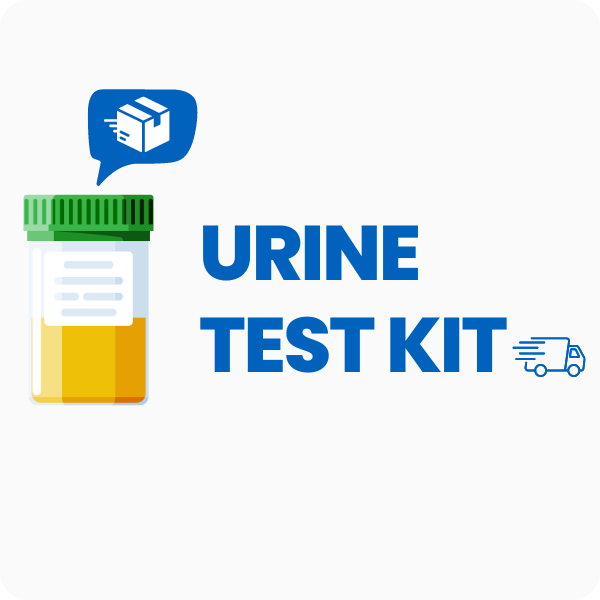Ordering the Amino Acids Test (24hr/Random) | Great Plains Labs | Canada
The Amino Acids Test (24hr/Random) from Great Plains Labs helps measure amino acids and related compounds in urine, giving a clear picture of protein breakdown and nutrient balance. This test can help find patterns linked to mood changes, muscle weakness, and metabolic issues. Interestingly, some amino acid imbalances can show up before symptoms like fatigue or headaches become noticeable, making early testing useful for tracking changes over time.
Ordering this test can help you:
- Identify specific amino acid deficiencies or excesses that may affect mood, energy, or muscle function
- Track protein metabolism and nutrient absorption for those with digestive concerns
- Monitor amino acid levels in people with chronic fatigue, migraines, or unexplained muscle pain
- Support targeted nutrition plans for those with metabolic or mood disorders
- Detect unusual patterns that may relate to skin, hair, or immune system changes
Who Should Consider Amino Acid and Protein Metabolism Testing
People who have ongoing tiredness, frequent headaches, or mood swings that do not improve with basic changes may benefit from this test. For example, someone who has tried different diets and supplements but still feels muscle weakness or has trouble sleeping could use this test to find out if amino acid imbalances are involved.
Ordering this test may also be helpful in these situations:
- Children or adults with learning or behavior challenges, such as attention or focus problems
- People with digestive issues like bloating or trouble absorbing nutrients
- Those with unexplained hair loss or skin changes
- Anyone with a family history of metabolic or genetic disorders
- People who notice a sudden change in how their body handles protein-rich foods, which can sometimes be linked to rare enzyme issues
Testing for amino acid levels can help pinpoint the cause of symptoms like fatigue, muscle pain, or mood changes by showing if the body is breaking down and using protein properly. Delaying this test could mean missing early signs of nutrient imbalances that may become harder to correct later. To move forward, order the test to get a detailed look at your amino acid profile.
Preparing for Urine Amino Acid Analysis
Fasting is not always required for this test, but it is important to check the kit instructions or ask your healthcare provider for specific guidance. Always follow the directions given by your doctor or healthcare professional to make sure your sample is collected the right way.
Labs Included When Ordering Your Amino Acids Test (24hr/Random) | Great Plains Labs
| Test Name | Reference Range | What This Biomarker Means | Low and High Levels of Amino Acids Test |
|---|---|---|---|
| Alanine | 30-400 | Alanine is an amino acid important for energy production and blood sugar balance. It helps the body convert sugars and supports muscle health. |
High levels mean possible muscle breakdown or liver stress.
Low levels mean possible poor protein intake or absorption. |
| Beta-alanine | 0-20 | Beta-alanine helps make carnosine, which supports muscle endurance and reduces fatigue during exercise. |
High levels mean increased muscle breakdown or metabolic changes.
Low levels mean reduced muscle performance or low intake. |
| Alpha-aminoadipate | 0-10 | Alpha-aminoadipate is involved in breaking down lysine, an amino acid needed for growth and tissue repair. |
High levels mean possible metabolic or kidney issues.
Low levels mean reduced lysine breakdown. |
| Alpha-aminobutyrate | 0-10 | Alpha-aminobutyrate is a byproduct of amino acid metabolism and can reflect liver or metabolic function. |
High levels mean increased protein breakdown or liver stress.
Low levels mean low protein turnover. |
| Gamma-aminobutyrate (GABA) | 0-20 | GABA is a neurotransmitter that helps calm the nervous system and supports mood balance. |
High levels mean increased nervous system activity or stress.
Low levels mean possible anxiety or mood changes. |
| Beta-aminobutyrate | 0-10 | Beta-aminobutyrate is a minor amino acid involved in protein metabolism and may reflect changes in energy use. |
High levels mean increased protein breakdown.
Low levels mean low protein turnover. |
| Ammonia | 0-50 | Ammonia is a waste product from protein breakdown. The body removes it through the liver and kidneys. |
High levels mean possible liver or kidney problems.
Low levels mean efficient ammonia removal. |
| Anserine | 0-10 | Anserine is a dipeptide found in muscle and brain tissue, supporting antioxidant activity and muscle function. |
High levels mean increased muscle breakdown.
Low levels mean low muscle mass or intake. |
| Arginine | 10-150 | Arginine is important for blood flow, immune function, and wound healing. It also helps remove ammonia from the body. |
High levels mean increased protein breakdown or metabolic stress.
Low levels mean poor intake or absorption. |
| Asparagine | 10-80 | Asparagine helps make proteins and supports nerve function. It is also involved in energy production. |
High levels mean increased protein breakdown.
Low levels mean low protein intake or absorption. |
| Aspartate | 10-80 | Aspartate is an amino acid that helps with energy production and supports the urea cycle for removing waste. |
High levels mean increased protein breakdown or metabolic stress.
Low levels mean low intake or poor metabolism. |
| Carnosine | 0-10 | Carnosine is a dipeptide that helps protect muscles from damage and supports exercise performance. |
High levels mean increased muscle breakdown.
Low levels mean low muscle mass or intake. |
| Citrulline | 0-20 | Citrulline is involved in the urea cycle, helping remove ammonia and supporting blood flow. |
High levels mean possible urea cycle disorder.
Low levels mean low intake or poor metabolism. |
| Creatinine | 500-2000 | Creatinine is a waste product from muscle activity and is used to check kidney function and muscle mass. |
High levels mean possible kidney issues or high muscle mass.
Low levels mean low muscle mass or poor kidney function. |
| Cystathionine | 0-10 | Cystathionine is part of the pathway that makes cysteine and helps with detoxification and antioxidant support. |
High levels mean possible vitamin B6 deficiency.
Low levels mean low intake or poor metabolism. |
| Cysteine | 10-80 | Cysteine is needed for making glutathione, a key antioxidant, and supports detoxification and immune function. |
High levels mean increased protein breakdown or oxidative stress.
Low levels mean low intake or poor absorption. |
| Cystine | 10-80 | Cystine is the oxidized form of cysteine and helps with protein structure and antioxidant defense. |
High levels mean increased oxidative stress.
Low levels mean low intake or poor metabolism. |
| Ethanolamine | 0-20 | Ethanolamine is involved in making cell membranes and supports nerve function and brain health. |
High levels mean increased cell breakdown.
Low levels mean low intake or poor metabolism. |
| Glycine | 30-400 | Glycine is important for making proteins, collagen, and neurotransmitters. It also helps with detoxification. |
High levels mean increased protein breakdown or metabolic stress.
Low levels mean low intake or poor absorption. |
| Glutamate | 10-80 | Glutamate is a neurotransmitter that supports brain function and is involved in energy production. |
High levels mean increased brain activity or metabolic stress.
Low levels mean low intake or poor metabolism. |
| Glutamine | 30-400 | Glutamine is important for gut health, immune support, and muscle recovery after exercise or illness. |
High levels mean increased muscle breakdown or stress.
Low levels mean low intake or poor absorption. |
| Histidine | 10-80 | Histidine is needed for making proteins and histamine, which supports immune response and stomach acid production. |
High levels mean increased protein breakdown.
Low levels mean low intake or poor absorption. |
| Homocysteine | 0-10 | Homocysteine is a byproduct of methionine metabolism and is linked to heart and blood vessel health. |
High levels mean increased risk for heart or blood vessel problems.
Low levels mean efficient metabolism. |
| Hydroxyproline | 0-20 | Hydroxyproline is a marker of collagen breakdown and can reflect bone or connective tissue turnover. |
High levels mean increased bone or tissue breakdown.
Low levels mean low collagen turnover. |
| Isoleucine | 10-80 | Isoleucine is a branched-chain amino acid important for muscle repair and energy during exercise. |
High levels mean increased muscle breakdown.
Low levels mean low intake or poor absorption. |
| Leucine | 10-80 | Leucine is a branched-chain amino acid that helps build muscle and supports energy production. |
High levels mean increased muscle breakdown.
Low levels mean low intake or poor absorption. |
| Lysine | 10-80 | Lysine is needed for growth, tissue repair, and making hormones and enzymes. |
High levels mean increased protein breakdown.
Low levels mean low intake or poor absorption. |
| Methionine Sulfoxide | 0-10 | Methionine sulfoxide is an oxidized form of methionine and can reflect oxidative stress in the body. |
High levels mean increased oxidative stress.
Low levels mean low oxidative activity. |
| Methionine | 10-80 | Methionine is important for making proteins and supports detoxification and antioxidant defense. |
High levels mean increased protein breakdown.
Low levels mean low intake or poor absorption. |
| 1-Methylhistidine | 0-10 | 1-Methylhistidine is a marker of muscle protein breakdown, especially from animal protein intake. |
High levels mean increased muscle breakdown or high meat intake.
Low levels mean low muscle turnover or low meat intake. |
| 3-Methylhistidine | 0-10 | 3-Methylhistidine is another marker of muscle protein breakdown and can reflect muscle loss or catabolism. |
High levels mean increased muscle breakdown.
Low levels mean low muscle turnover. |
| Ornithine | 0-20 | Ornithine is part of the urea cycle, helping remove ammonia and supporting liver function. |
High levels mean possible urea cycle disorder.
Low levels mean low intake or poor metabolism. |
| Phenylalanine | 10-80 | Phenylalanine is needed for making proteins and neurotransmitters that affect mood and brain function. |
High levels mean possible metabolic disorder (like PKU).
Low levels mean low intake or poor absorption. |
| Phosphoethanolamine | 0-20 | Phosphoethanolamine is involved in making cell membranes and supports nerve and brain function. |
High levels mean increased cell breakdown.
Low levels mean low intake or poor metabolism. |
| Phosphoserine | 0-20 | Phosphoserine is a modified amino acid involved in cell signaling and protein function. |
High levels mean increased cell turnover.
Low levels mean low protein turnover. |
| Proline | 10-80 | Proline is important for making collagen and supports skin, joint, and connective tissue health. |
High levels mean increased collagen breakdown.
Low levels mean low intake or poor absorption. |
| Sarcosine | 0-10 | Sarcosine is a byproduct of glycine metabolism and can reflect changes in methylation or detoxification. |
High levels mean increased methylation activity.
Low levels mean low intake or poor metabolism. |
| Serine | 10-80 | Serine is needed for making proteins, cell membranes, and neurotransmitters. |
High levels mean increased protein breakdown.
Low levels mean low intake or poor absorption. |
| Taurine | 10-80 | Taurine supports heart, brain, and eye function and helps regulate fluid balance. |
High levels mean increased intake or metabolic changes.
Low levels mean low intake or poor absorption. |
| Threonine | 10-80 | Threonine is needed for making proteins, collagen, and supports gut and immune function. |
High levels mean increased protein breakdown.
Low levels mean low intake or poor absorption. |
| Tryptophan | 10-80 | Tryptophan is needed for making serotonin and melatonin, which support mood and sleep. |
High levels mean increased protein breakdown.
Low levels mean low intake or poor absorption. |
| Tyrosine | 10-80 | Tyrosine is needed for making neurotransmitters and supports mood, focus, and stress response. |
High levels mean increased protein breakdown or metabolic disorder.
Low levels mean low intake or poor absorption. |
| Valine | 10-80 | Valine is a branched-chain amino acid that helps with muscle repair and energy during exercise. |
High levels mean increased muscle breakdown.
Low levels mean low intake or poor absorption. |
| Urea | 200-800 | Urea is a waste product from protein breakdown and is used to check kidney and liver function. |
High levels mean increased protein breakdown or kidney issues.
Low levels mean low protein intake or liver problems. |
Reference ranges may change slightly as labs update their methods or as new research becomes available.
Amino Acids Test FAQ
Is there Amino Acids Test testing near me?
This test is a home collection kit, so you can collect your urine sample locally and use the draw location link for help if needed. For people with ongoing fatigue, muscle pain, or mood changes, having a convenient way to collect your sample at home makes it easier to get answers without extra travel or waiting.
How do I interpret the test results?
While your treating physician should review your results, you can also use our one-on-one test results review service with our clinical team for a detailed explanation.
What is the cost of the test?
The price shown for this test includes standard shipping to you and return shipping to the lab, but draw fees may apply. Ordering this test can help you find out if amino acid imbalances are causing symptoms like fatigue or muscle weakness, so you can address them sooner.
How often should I retest?
Retesting is usually recommended every 6 to 12 months, especially if you are making changes to your diet or treatment plan. Regular testing helps track progress and adjust your plan if amino acid levels change over time.
How accurate is the test?
This test uses high-performance liquid chromatography with tandem mass spectrometry (HPLC-MS/MS) for precise measurement of amino acids, with a specificity of 98% and sensitivity of 97%. TrueHealthLabs.com partners with CLIA-certified and CAP-certified laboratories to uphold rigorous testing standards for dependable results.
Important Notes
- This test can not be collected or mailed from New York State. Contact us with questions.
Medical Review Board
Reviewed by Jeff Donohue M.D. from Body Logic and Brady Hurst DC, CCCN. Written by True Health Lab’s team of editorial health contributors.
Disclaimer: This information is for educational purposes only and not intended as medical advice. Consult your healthcare provider for personalized guidance.
Why Customers Trust True Health Labs – What People are saying
Also rated 4.6 out of 5 based on 3452 ShopperApproved reviews- See all TrueHealthLabs.com reviews.








